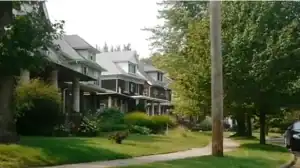By Ron Calhoun
Cuyahoga County’s Land Bank began as a residential tool. Today, its priorities seem to serve institutions and commerce over individuals.
From Renewal to Redevelopment
In Cuyahoga County, Ohio, longtime builder and resident Ron Calhoun has watched the county’s Land Bank evolve from a neighborhood renewal program into an engine for developer-driven projects.
Over the past decade, changes in land transfer rules and funding priorities have moved the focus from individual homeowners to large commercial and institutional partners, raising questions about who truly benefits from the city’s redevelopment policies.
According to county regulations and public reports from the Cuyahoga County Land Bank, the shift since 2018 from affordable, transparent land sales to large-scale deals with well-connected developers. The board, which includes local government officials, has raised urgent concerns about transparency, equitable access, and diminishing opportunities for longtime residents to rebuild and sustain their neighborhoods.
The Shift Toward Institutional Control
But by the late 2010s, that mission began to change. Amendments made between 2018 and 2022 shifted the Land Bank’s focus away from individuals and toward institutional development. Revised policies gave the executive staff broad power to negotiate property sales directly with “strategic partners”, a category that includes large developers and community development corporations, or CDCs.
(Source: Cuyahoga County Land Bank Code of Regulations, cuyahogalandbank.org)
Entire clusters of parcels can now be bundled and transferred through requests for proposals or “special project” agreements. In practice, only well-connected organizations have the capacity to compete. Public auctions and open sales, once the heart of the program, have largely disappeared.
With the city’s support, I built a 2,610-square-foot home. I received a $5,000 discretionary grant and a 10-year tax abatement, with the understanding I’d repay the grant if I sold the house early.
It wasn’t a handout; it was a partnership that encouraged long-term ownership according to the Cuyahoga County Land Bank Code of Regulations..
That partnership reflected the original spirit of what would later become the Cuyahoga County Land Bank, a program created to return abandoned property to community hands, not private control.
Established in 2009 under Ohio Revised Code 1724, the Cuyahoga County Land Reutilization Corporation was designed to “reclaim, rehabilitate, and reutilize vacant, abandoned, or tax-foreclosed real property for the public good.”(Sources: Ohio Revised Code Section 5722,ohio.gov)

A Homegrown Start: Building from the Ground Up
When I was growing up in Cleveland, the city was full of boarded-up homes and vacant lots. In 1992, my wife and I decided to help rebuild my neighborhood. Through the city’s land bank, We bought a parcel at a public auction, a fair, transparent process that allowed residents to reinvest where they lived.
Original Mission: Reclaiming Land, Restoring Neighborhoods
In its early years, the Land Bank focused on people, not profits. Homeowners, small nonprofits, and block clubs could buy lots directly. Side-yard and owner-occupant programs gave Clevelanders a chance to expand their properties or build new homes. Land sales were public, affordable, and transparent.
Who Benefits, and Who’s Left Out
The Land Bank’s current board includes the county executive, treasurer, and council president, along with city and suburban officials. This structure ensures political oversight but also ties the Land Bank’s priorities to government-led redevelopment plans.
Property transfers now mainly flow to established Community Development Corporations (CDCs) such as Slavic Village Development, Metro West, and Famicos Foundation, or to developers working in designated growth corridors.(Source: Cuyahoga Land Bank Board of Directors, cuyahogalandbank.org/about/our-team)
These projects have brought visible investment but at the cost of public access. Residents who could once buy a single lot now see entire blocks handed to developers through negotiated deals. Small community groups face more paperwork, fewer opportunities, and less transparency.
Transparency at a Crossroads
The shift also mirrors a broader trend in county policy. Cuyahoga County’s plan to sell delinquent tax liens Cleveland.com reported, once a key pipeline for Land Bank acquisitions, was recently stalled, raising further questions about transparency and accountability in how distressed properties are managed (Source: Cleveland.com, “Cuyahoga County’s plan to sell delinquent tax liens stalled,” Oct. 2025)
The Land Bank still describes its work as “returning property to productive use.” But the definition of “productive” has changed. Where the system once built equity and stability for local families, it now builds leverage for institutions.
Reclaiming the Promise
Cleveland residents have voiced growing concerns about how large-scale redevelopment projects are reshaping their neighborhoods. Many worry that the loss of smaller, homeowner-driven initiatives has brought new challenges: heavier traffic, limited parking, and rising rents as multi-unit complexes replace single-family homes.
Residents in areas like Hough, Glenville, and University Circle report that once-quiet residential streets now feel commercialized, with increased noise, transient renters, and reduced green space. These frustrations often stem not from opposition to growth but from a sense that decisions are being made without their input.
The lack of early, transparent communication about project size, scope, and impact has left communities feeling excluded from planning processes that directly affect their daily lives.
To rebuild trust and balance progress with preservation, residents and policy advocates are calling for stronger safeguards. They recommend that the Land Bank and its development partners prioritize open communication through mandatory accessible public meetings and clear project updates. Thorough impact assessments, especially traffic and parking studies, should be conducted before approvals, with findings shared publicly.
Maintaining neighborhood character through scale and design standards is key to protecting Cleveland’s distinctive residential feel. Equally important is balancing ownership and rental opportunities so long-term residents can remain invested in their blocks. True community renewal requires not just new construction but consistent engagement, ensuring residents have a real voice in shaping the future of the places they call home.
When we stood on our empty lot three decades ago, we saw possibility, a chance to rebuild a block, not just a house. That vision is still possible if we return to transparency and fairness.
Opening auctions to individuals again, restoring owner-occupant programs, and publishing public reports on who receives property transfers would be good places to start.
The Land Bank was born from crisis to serve the community. Its future depends on whether it can still remember who that community is.





